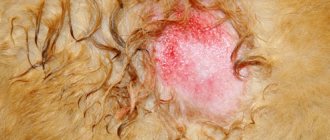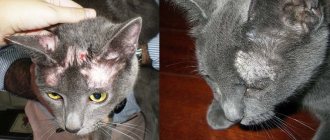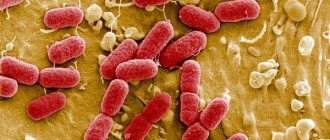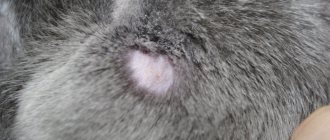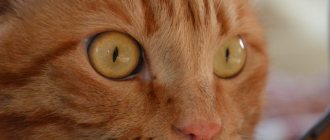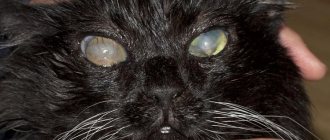Eczema in cats is one of the most common dermatological diseases in pets. It is not contagious because it is allergic in nature. It is characterized by a chronic course with periodic relapses in the form of rashes. They are usually polymorphic, that is, they can vary from ordinary hyperemia to purulent ulcerations. A common symptom of all types of eczematous rashes is uncontrollable itching. In this article we will look at the types of eczema, the mechanism of their development, characteristic symptoms, as well as treatment methods.
Types of eczema
If your cat exhibits these signs, you need to quickly take the animal to a veterinary clinic. The veterinarian will conduct an examination and accurately determine the type of eczema.
There are two types of disease:
- Dry eczema - older animals are more likely to suffer; In this species, dry scales with further exfoliation are observed, the lesion does not spread.
- Wet eczema is difficult to cure. The lesion spreads, infecting new areas of the skin. The skin festers and becomes wet.
Symptoms of the disease
An attentive owner can recognize the onset of the disease in a cat. It is characterized by special features. This should be a signal to urgently show the animal to a veterinarian.
- The disease often debuts in young animals, whose age does not exceed 1-2 years.
- Skin itching, localized on the neck, along the spine or on the muzzle, forces the animal to scratch these places again and again and lick them.
- The skin on the affected areas is tense and inflamed. By touching it, you can feel a local increase in temperature.
- The fur here thins out, making it possible to notice the appearance of rashes.
- In advanced cases, the eczematous rash takes the form of ulcerations or ulcers.
- The appearance of crusts of dried exudate indicates the beginning of the healing stage.
Causes of the disease
Often the root cause of eczema in cats is more serious diseases. After the examination, the veterinarian prescribes urine and blood tests for the animal. Based on laboratory data
Through research, the doctor identifies the cause of the disease.
Eczema is classified according to the causes of the disease.
- Reflex eczema. The causes are thermal burns, frostbite, allergies to medications or other irritants, and disturbances in the functioning of the body.
- Neuropathic eczema. Occurs in cats that have experienced or are constantly experiencing severe stress. The development of this species is typical for animals with disorders of the nervous system.
- Traumatic eczema. Formed when the skin is damaged as a result of scratches, wounds, insect bites and other animals, as well as when wearing a tight collar and other accessories.
The development of eczema in a cat is also influenced by poor nutrition, weakened immunity, dirty skin and fur of the animal.
Causes of eczema
Veterinary specialists distinguish several reasons leading to the development of the disease in domestic cats. They are usually classified into groups according to the type of disease they cause.
Reflex
The causes of this group affect the skin both externally and internally. Of the external factors, mechanical, thermal, chemical and microbial influences most often lead to the development of eczema. Mechanical causes - friction, scratching for skin diseases, exposure to external parasites.
Thermal factors include exposure to cold, hot air, burns and frostbite on the skin. This group also includes exposure to ionizing radiation on animals.
The causes of skin diseases of a chemical nature include irritating acids, alkalis, chemicals, aggressive detergents, medications in the form of ointments, purulent discharge during inflammatory processes.
Exposure to skin microorganisms can be both a direct and indirect cause of the development of eczema.
Experts include diseases of animal organs as internal irritants: thyroid, liver, ovaries, kidneys, intestines. The products of inflammatory reactions, spreading through the bloodstream, have an irritating and sensitizing effect on skin cells.
Often the cause of the reflex form of the disease is an allergic reaction of the body to a particular allergen.
Neuropathic
The cause of the disease is vegetative disorders caused by genetic pathologies and congenital diseases. Stress is one of the main mechanisms that triggers the neuropathic form of pathology. Eczema due to neuropathic causes usually has a poor prognosis.
Traumatic
The triggering cause is a variety of wounds, mechanical irritations of the skin, abrasions, and insect bites.
Factors such as inadequate feeding, impaired vitamin and mineral metabolism, and hormonal changes can also provoke the development of one form or another of the disease.
Treatment of the disease
After examination and laboratory tests, the veterinarian determines the type and stage of eczema and the pet, and prescribes treatment. Therapy is selected individually, based on the severity of the animal’s condition and the stage of the disease. It is strictly forbidden to treat your cat yourself. Only a specialist can correctly prescribe treatment and save the animal.
First of all, the doctor prescribes antibiotics and sedatives. Hydrogen peroxide or alcohol is used for disinfection. To dry the affected area of the skin, treatment is carried out with brilliant green and iodine, and to moisturize dry eczema, it is lubricated with special moisturizers.
Without exception, all cats with eczema are prescribed vitamin complexes to support the immune system and follow a fermented milk diet. If the skin affected by eczema still has fur, it should be shaved off to facilitate access to the source of the disease.
Traditional medicine can be used as an addition to basic therapy, but only after consulting a doctor.
Almost all folk remedies are decoctions and ointments for external use. Drug treatment in combination with traditional medicine gives good results and has a positive effect on the dynamics of the animal’s recovery.
Drugs for the treatment of eczema in cats
Treatment is selected by a veterinarian, and general recommendations for caring for the pet during this period are given. An integrated approach allows you to alleviate the condition in a short time, and remission occurs.
Drug therapy is prescribed taking into account the stage of development of the disease and the nature of its course. To relieve nervousness in your pet, which develops due to itching and discomfort, medications with a sedative effect are prescribed.
The next step requires the use of desensitizing agents. For this purpose, intramuscular injections are prescribed:
- sodium thiosulfate;
- calcium chloride preparations.
Antihistamines (Suprastin, Diphenhydramine) are prescribed for internal use. In severe cases of the disease, glucocorticosteroids are required. It could be:
- Prednisolone;
- Dexamethasone.
Hormonal drugs have serious contraindications and can cause side effects. It is prohibited to change the dosage for the animal prescribed by the veterinarian and the duration of treatment.
Diuretics are required to remove toxins from the body:
- Furosemide;
- Hypothiazide.
During the treatment period, a course of vitamins and immunostimulants is necessary. Attention should also be paid to proper treatment of the dermis. Drugs are selected depending on the type of eczema. With a weeping form, astringents are needed (silver nitrate, Rivantol). It is also necessary to treat the skin with antiseptics - Chlorhexidine solution, Miramistin.
Hormonal hydrocortisone and prednisolone ointments are used when there is no large exudate discharge. Flucinar is an ointment containing hormonal anti-inflammatory components. Helps relieve the sensitizing effect of irritants.
For dry eczema, the skin should be treated with Vishnevsky ointment. Accelerates wound healing Levomekol - chloramphenicol, which is the active component of the product, inhibits pathogenic microorganisms. Vedinol ointment also accelerates wound healing.
Disease Prevention
Eczema in cats is difficult to treat. Complete recovery can be achieved only at the initial stage of the disease. To prevent the development of eczema in a cat, you should follow certain rules:
- The pet must be kept in a clean and dry home.
- Maintain animal hygiene.
- The cat's diet must contain all the necessary vitamins and microelements.
- The animal must be treated for skin parasites and helminths.
- If a cat has diseases of internal organs, they must be treated.
- Protect the animal from stress.
- Cat collars must be selected strictly according to the size of the animal.
Cats with long hair are more susceptible to eczema than short-haired cats, so do not neglect routine examinations at the veterinary hospital.
A healthy cat is a joy for the owner. If your pet exhibits symptoms of any disease, you should immediately contact a veterinarian. It is advisable to choose a proven clinic with good reviews. A person without proper education and experience will not cure a pet, but will only harm him and you.
Caring for the health of a pet is the direct responsibility of any owner. We are responsible for those we have tamed.
Mechanism of development of eczema
Since the skin is connected to the internal organs, their condition is also interdependent.
Eczematous skin lesions most often appear against the background of metabolic disorders. Disturbed processes of heat exchange, sweating and vascular reactions increase skin sensitivity when exposed to various types of allergens. This leads to the development of various types of eczema in the animal.
Toxic metabolic products entering the blood (due to disruption of the gastrointestinal tract or excretory system) cannot be completely neutralized in the liver, but are partially excreted through the skin. This also leads to the appearance of secondary foci of inflammation. In its development, eczematous lesions go through several stages:
- At the erythema stage, itchy redness appears on the surface of the skin, which spreads when scratched and can cause infectious complications.
- The papular stage replaces the erythematous stage and is characterized by the appearance of compactions, or so-called nodules (papules), rising above the surface of the skin in the affected areas.
- The vesicular stage occurs when papules turn into vesicles - vesicles filled with serous contents.
- In the future, if the disease takes the path of developing dry eczema, the blisters gradually resolve. In their place, a dry, flaky and flaky surface appears.
- If wet eczema develops, the contents of the vesicles are replaced by a leukocyte infiltrate. The vesicles are replaced by pustules (ulcers). When they open, they form a continuous ulcerated surface with pus. This form of the disease is the most dangerous and fraught with complications.
Types and stages of eczema
A disease of the epidermal layer of the skin, accompanied by an inflammatory process - weeping eczema occurs in stages. The course can be acute, subacute and chronic. In a chronic course, the disease seems to linger at one of the stages, most often the last.
The acute stage of eczema (erythomatous) is characterized by the appearance at the site of the lesion of polymorphism changes, consisting of parts of pigmented skin tissue and convex seals.
This is followed by an increase in local temperature, expansion of the red spot and the appearance of itching. The reddened area is painless.
The first acute stage passes into the second - papular stage in a few hours (2-3 days). On the pigmented, overgrown spot, nodules and papules appear, dense to the touch, slightly larger than a poppy seed. Merging, the grains turn into pea-sized vesicles filled with translucent light exudate.
The third vesicular stage can occur in different ways.
One option: the liquid that appears in the bubbles is “drawn” back into the skin and the tissues dry out. The horny cells of the epidermis are gradually rejected, the formation of new vesicles stops, and the skin takes on a healthy appearance.
Option two: The peas open under the pressure of the liquid filling them or when combing. Pyogenic microbes get on the skin and pustules form. Soon, under the pressure of purulent exudate or scratching, the blisters (pustules) open again, and the microbes again enter the skin. Hyperemic, swollen skin in the area of exudate becomes covered with erosive ulcers. The stage is called pustular.
This sad picture is usually called weeping eczema, although weeping eczema in cats, as you have seen, is a long process! In the eczema zone, part of the hair falls out, the other is stuck together with liquid from burst vesicles and pustules.
What's next? If the area of skin eroded by eczema can “breathe” freely and does not receive additional moisture from the outside (do not get it wet!), then the surface sooner or later goes into the “crusted” stage. Exudative processes attenuate, fresh crusts thicken, darken, dry out and eventually fall off. The swelling and redness disappear, and new, smooth skin without damage is revealed under the fallen off crusts.
The unfavorable course of weeping eczema turns into a chronic subacute form. At this stage, eczema is difficult to treat, the prognosis is unfavorable and very cautious.
As exudation increases, the affected area expands, and the eczema is complicated by a purulent infection; the affected area is covered with a thick purulent layer.
The areas of ulceration expand and deepen, phlegmon begins when the subcutaneous soft tissues are included in the process of purulent inflammation. Cellulitis spreads quite quickly in the area of fiber, muscles and tendons, and in an advanced stage, even the internal organs of the cat can be affected.
Treatment methods
For a successful and rapid recovery of your pet, you must strictly follow all medical recommendations without deviating from the treatment regimen. In some situations, taking medications can last for almost a month, despite the disappearance of symptoms. This duration is explained by the need to eliminate all internal violations that can only be monitored using equipment.
Medicines prescribed by a veterinarian
First of all, the main cause of the ailment is eliminated: the material of the collar is changed, allergenic foods are removed from the diet and the diseases found are treated. In case of severe intoxication, the animal is given cleansing drips with saline and glucose: they help normalize the water-salt balance and improve overall well-being.
Most often, a sick animal is treated with the following drugs:
- antibiotics (Amoxicillin, Erythromycin, Sinulox) that fight the infectious agent;
- antihistamines (Suprastin, Cetrin, Diphenhydramine) and glucocorticosteroids (Prednisolone, Dexamethasone), which suppress the body’s excessive sensitivity;
- anthelmintics (Milbemax, Drontal, Profender), destroying adult parasites and their larvae;
- hepatoprotectors (Hepatovet, Covertal, Hepatoject), restoring liver functionality;
- sedatives (Stop-stress, Cat Bayun), preventing exacerbation of neuropathic diseases;
- diuretics (Furosemide, Hypothiazide), facilitating the removal of toxins;
- immunomodulators (Gamavit, Catozal, Vitam), stimulating the work of immune cells.
To treat weeping eczema in cats, antiseptics (miramistin, chlorhexidine) and antimicrobial agents are used, which have a healing effect and effectively dry out wounds. The dry appearance, on the contrary, is moistened using naphthalan ointment and Vishnevsky liniment.
Acceptable use of folk remedies
At home, treatment for eczema in cats may include folk remedies. These include:
- aloe juice, which improves tissue regeneration;
- infusion of currant leaves, which improves immunity;
- sea buckthorn and St. John's wort oil, which relieves pain and inflammation;
- a decoction of oak bark and chamomile, which eliminates irritation and protects against germs;
- an infusion of burdock and dandelions, which normalizes metabolism and has a diuretic effect;
- a compress of celery and sunflower oil, recommended for eliminating dry inflammation.
All of the listed remedies are used as part of complex therapy and do not exclude taking medications from the pharmacy. Before using them, be sure to make sure there is no allergic reaction by dropping a small amount of infusion or ointment on the skin.
Remember that some traditional medicine recipes can be deadly. These products include birch tar and other tar-containing preparations. They are poisonous to the feline family, so be sure to consult your veterinarian about acceptable prescriptions during diagnosis.
Hygiene and maintenance of a sick pet
The hair on the affected areas must be cut or shaved, treating the skin with a neutral antiseptic. To avoid enlargement of pathological lesions, your pet should be wearing a protective collar - it will prevent scratching of wounds and licking of healing ointments.
Carry out wet cleaning daily in the room where the sick animal is located. Pay special attention to his sleeping place and feeding troughs.
Be sure to make sure there are no drafts. Remember that during treatment the immune system is very weak and vulnerable to colds and infections. If the cat is used to walking outside, put him in quarantine until he recovers.
Try to minimize stress by keeping your pet away from noisy children and overly active pets. Remember to give sedatives as prescribed by your veterinarian.
Review your diet by eliminating the most common allergens: fish, eggs, chicken, wheat and other grains. When dry feeding, it is recommended to switch to hypoallergenic food. If your pet is accustomed to natural products, be sure to add vitamins prescribed by your doctor to his food.
Dangerous skin diseases of cats
Caused by internal pathologies or quickly progress to the stage of exacerbation, life-threatening.
Demodicosis
Microscopic mites are very active. Poisoning from bites spreads so quickly and abundantly that many cases of death are known.
In a mild form, white pimples with pus, partial baldness, red crusts, scratching and a small rash are noticeable on the skin. Over a long period of time, the cat easily scratches the pustules until they become ulcers, introduces infections and bacteria, becomes very weak, and loses appetite.
Demodicosis in cats
Ostiofolliculitis
Ulcers are located in hair follicles. The hair bag becomes clogged with sebum, becomes inflamed, and a staphylococcal bacillus settles inside the bag. If the disease is not treated at the beginning, it quickly progresses into acute furunculosis and peptic ulcer.
It can be detected by redness around the roots of the hairs, purulent pimples up to the size of a pea, burst blisters with crusts on top. The cat becomes restless and does not allow itself to be petted, as touching causes pain.
Ostiofolliculitis
Abscesses
Inflammation in the form of a soft cyst or lump on the skin. There is a lot of purulent exudate inside it. It starts to smell after it bursts and the liquid leaks onto the skin. The smell is especially pungent and unpleasant. Large abscesses greatly impair immunity. The cat may contract an infection during treatment. Therapy is also not fast. Drains are placed in the burst wound to remove all remaining fluid. We have to use strong antibiotics.
Abscesses on a cat's neck
Malasseziosis
Fungal infection. One of the most difficult to treat skin diseases in cats. Diagnosis is difficult and the course is protracted. Treatment requires heavy drugs that harm the rest of the body.
The characteristic smell gives off mold, spoiled cheese or milk. In the groin, near the back opening, behind the ears, near the mouth, claws and nose, you can find redness, rashes, moisture, and sores. The skin becomes painful, so the animal cannot be handled, hisses, and scratches. Relapses occur frequently and for a long time.
Malasseziasis is one of the most difficult to treat skin diseases in cats.
Ringworm
Pathology of an infectious fungal nature. Kittens and cats with oncology or weakened immunity after viruses are more often susceptible.
Fungal spores can be brought to your pet on street clothes or shoes. Spread occurs through household items and personal contact between animals.
The cat is actively losing hair on its head, limbs and tail. The skin in exposed areas peels, itches, becomes very red and pink. In these areas, pustules and crusts appear, which are easily scratched off with claws to open wounds. The disease can gain momentum for up to 2 years. With this course, the pet quickly weakens, loses weight, stops eating and may die from exhaustion. During this period, it is easiest to become infected with fatal infections, since the body does not have the strength to resist viruses. In severe cases, the ulcers spread to the paw pads and it becomes difficult to move.
Ringworm
Treatment without the participation of a doctor is impossible.
Atopic dermatitis
Chronic allergic reaction of the skin to irritants. The body reacts to dust, mold, pollen, household chemicals, and food with severe itching, rashes, hair loss, and ulcers. The cat will scratch especially a lot on the head, ears, chest, neck, lower abdomen and thighs. Dermatitis is severe and weakens the animal. Ulcers are constant and profuse. It is difficult to select living conditions and food for the safe living of a pet.
Atopic dermatitis is a chronic allergic reaction of the skin to irritants
Cushing's syndrome
A rare hormonal disease, a reaction to too high levels of cortisol in the blood. Side effect of pituitary disease, adrenal tumors, injections and oral corticosteroids.
The cat suffers from thinning skin, acne with a small amount of pus. It scratches them off, which can result in difficult-to-heal wounds. The disease causes gluttony, a swollen abdomen, constant thirst, frequent urination, lethargy, muscle weakness, and hair loss.
Treatment is long and difficult. A severe metabolic disorder in the body may occur, leading to exhaustion and diabetes.
Cushing's syndrome is a rare hormonal disease, a reaction to too high levels of cortisol in the blood.
Allergic skin diseases
Many breeders associate the word “allergy” with a runny nose, watery eyes and other minor troubles. This is partly true, but allergic reactions in practice are much more dangerous. In particular, they are considered the main cause of incurable and deadly diseases, but even in “moderate” cases of pathology, these pathologies can cause a lot of trouble.
Allergic dermatitis
Dermatitis is a pathology accompanied by inflammation of the skin. Accordingly, in this case, the inflammation is caused by a serious allergic reaction.
Firstly, the latter leads to a catastrophic weakening of the skin’s protective mechanisms, which is why it can no longer resist the action of pathogenic and conditionally pathogenic microflora.
Secondly, a much worse option is possible: due to increased vascular permeability, lymphocytes begin to migrate en masse into the thickness of the epithelium. This effect is called lymphocytic or neutrophil infiltration and, by the way, it often leads to the development of autoimmune inflammation. Stress factors accelerate and intensify the pathological process.
Symptoms of allergic dermatitis in cats
Unlike “simple” inflammations, the symptoms of which develop over a long period of time, allergies are lightning fast. Just yesterday, your cat could just be itching, and by morning, large areas of her skin would become inflamed. It becomes swollen, turns red, and acquires a slightly “watery” consistency of dense jelly.
Another sign of the allergic nature of the disease is always itching. It is so strong and exhausting that the cat can tear off shreds of skin by scratching it furiously. All this leads not only to the formation of many scratches and even wounds on the skin, but also to its purulent inflammation (due to the ubiquitous pathogenic microflora).
Treatment
First, it is necessary to stop the allergic reaction, which is quite enough to treat mild and unadvanced cases.
The animal is prescribed loading doses of antihistamines (which include the widely used Diphenhydramine).
To prevent the development of secondary bacterial infections, broad-spectrum antibiotics are prescribed.
To eliminate diffuse areas of inflammation, anti-inflammatory corticosteroids are needed. Their advantage is that they significantly reduce the risk of developing autoimmune pathologies. The most common and effective medication is prednisolone. Its average dose is 0.1 mg per kilogram of live weight (once a day).
Often these drugs have to be used for a long time, several weeks. To shorten the treatment period, it is much more practical to simultaneously administer dexamethasone. This remedy allows you to reduce the dose of corticosteroids and reduce the period of their use.
Milliary dermatitis
One of the varieties of the previous pathology. However, this disease has specific features that make it possible to distinguish it into a separate subsection.
Symptoms
The disease also begins with severe itching and swelling, but edematous phenomena are rare, and instead of them numerous nodular rashes appear on the skin. Hair falls out en masse on the affected areas of the body, and the pet’s resting places are simply littered with it.
Treatment is similar to that for ordinary allergic dermatitis.
Allergic eczema
In many ways, this disease is similar to the previous one, but still it differs in a number of specific aspects, which is why these pathologies should not be considered comprehensively.
Symptoms
- It all starts with an itch.
- Soon, slight redness appears on the skin of the sick animal.
- Red spots turn into ulcers and erosions. They are instantly contaminated with secondary bacterial microflora, resulting in purulent inflammation with itching.
- The inflamed areas are very painful, the sick cat’s condition quickly deteriorates, and he refuses to eat.
- The fur on the affected areas partially falls out and partially sticks together due to pus.
- The skin along the boundaries of healthy and inflamed areas macerates and swells.
Treatment
Similar to the treatment of allergic dermatitis. It differs only in large doses of corticosteroids, the mandatory prescription of large quantities of antihistamines (to quickly relieve itching) and dexamethasone.
Additionally, broad-spectrum antibiotics, without which it will not be possible to cope with bacterial inflammation.
Prevention of skin diseases in cats
Prevention includes the following measures:
- timely treatment of the skin from cutaneous and subcutaneous parasites;
- annual vaccination;
- compliance with hygiene standards;
- proper nutrition;
- regular cleaning of carpets;
- washing floors and toys;
- wearing flea and tick collars;
- inspection of the animal after a walk.
Once a skin disease is detected, the animal must be under constant supervision. It is necessary to give your pet medications in a timely manner, carry out the necessary treatment, and monitor his well-being.
Video
Veterinarian treatment
It is very important to collect as detailed an anamnesis as possible, i.e. find out all the nuances and details of the circumstances under which eczema arose, how long it has been there and at what speed it develops. A good specialist always asks a lot of questions. Next, primary treatment of the eczema surface is performed and treatment is prescribed.
Important: therapy in some cases may take more than 3 weeks. You cannot stop treatment at the moment when it visually begins to seem that the skin condition has improved and everything will heal on its own. It won't heal!
- Unscheduled treatments for worms and skin parasites are prescribed. Remove collars, bandages, etc.
- A course of treatment for the underlying disease is prescribed if it is determined that eczema is caused by internal pathologies of organs and their systems.
- If there are signs of internal intoxication, cleansing droppers are prescribed in doses determined by a veterinary specialist: glucose 5%;
- Ringer's or Ringer-Locke solution%
- saline solution with the addition of sodium thiosulfate.
Taking liver medications is indicated:
- hepatoject: maximum dose of 2 to 5 ml per animal, administered subcutaneously or intramuscularly 1-2 times over 5-7 days;
- Covertal: 0.1 ml/kg intramuscularly or subcutaneously for up to 2 weeks;
- hepatovet: 2-3 times a day orally through the mouth, 1-2 ml for 3-5 weeks;
- Legafiton: ½ tablet per day for 3 weeks.
Treatment
Be sure to cut the hair at the affected areas and wash the surface with antiseptic preparations:
- chlorhexidine is an excellent antibacterial drug with a neutral pH that does not cause local burning;
- hydrogen peroxide - used less often, causes a feeling of irritation;
- decoction of chamomile or burdock.
Local ointments
Creams, ointments or sprays are prescribed locally, depending on the nature of the eczema and whether it is dry or weeping. The composition may include glucocorticoids, antimicrobial, antifungal, wound-healing, drying components. The rule “moisten dry, dry dry” works the same as for other wounds. It often happens that during a course you have to change one ointment after another, eliminating the symptoms gradually.
The frequency of application and duration of the course are determined only by the veterinarian, based on what he saw during the examination of the animal. The most common drugs:
- Aluminumspray;
- Chemi spray;
- Zoomekol;
- Safroderm-gel;
- Triderm;
- Vedinol;
- Ranosan or Levomekol;
- natural sea buckthorn or St. John's wort oil.
Cats are prohibited from tar-containing preparations, because Tar is poison for cats!
Oral antibiotics must be prescribed
It has been practically proven that tablet forms of antibacterial drugs help with eczema much more effectively. It is also inconvenient to give injections due to the duration of the course (2-3 weeks). Most often prescribed:
- Sinulox 50: ½ to 2 tablets (12.5 mg/kg) twice a day for 2 weeks;
- Amoxicillin 100: 1/4-1 tab. twice daily (12.5 mg/kg) for 14 days. If necessary, the course is extended to 21 days;
- Ciprofloxacin 250: ¼-1/2 tablet/cat, depending on the size of the individual, twice a day for 2 weeks;
- Erythromycin: 10-20 mg/kg once a day for 14 days.
For almost all eczema, metabolic drugs, immunomodulators and vitamins must be prescribed
With one caveat: for allergies, vitamin preparations are not prescribed, because they themselves can provoke the progression of the disease.
The dosages of the following drugs are the same: 0.5-2 ml per animal, administered subcutaneously 1-2 times a day for 7 days:
- Katozal;
- Gamavit;
- Vitam.
Antipruritic (antihistamine) drugs
Be sure to relieve itching, because... he can be intolerable. In this case, skin injury will not stop. Apply:
- Cetrin: ¼-1/2 tablet. depending on the size of the cat, twice a day for 5-7 days;
- Dexa-Kel: 0.3-1 ml/cat intramuscularly once a week;
- Stop-Itch: 0.25-0.5 ml/animal orally into the mouth in the following course: 4 days full dose, then another 8 days at half the dose.
Sedatives
They are designed to calm the animal and prevent exacerbation of the disease due to nervousness:
- Cat Bayun: 2 ml orally 2-4 times a day for a course of 7 days once a month;
- Stop stress: for every 5 kg of weight ¼ table. orally twice a day for 15-20 days in a row.
Folk remedies
can also help treat eczema, but should not be used without first consulting a veterinarian:
- decoction of willow bark (boil 2 tablespoons of bark in 1 glass of water, simmer for 10 minutes at low boil, cool, strain, rinse the affected surface several times a day);
- infusion of dandelions and burdock roots (2 tablespoons of each ingredient are poured with ½ liter of vodka and infused for 10 days in a dark place: twice a day, gently lubricate the affected areas with cotton wool until the itching subsides);
- homemade celandine ointment (4 parts Vaseline is 1 part finely chopped and ground into a paste of celandine: apply to eczema 2-3 times a day until complete healing and disappearance of all symptoms);
- infusion of currant leaves (a squeeze of dry or fresh currant leaves is poured with two glasses of boiling water, infused for at least 1 hour, filtered: wet wounds are washed several times a day);
- compress of sunflower oil with celery (finely crushed celery root is thoroughly mixed with ordinary, unrefined vegetable oil to a paste and applied to the affected skin 2-3 times a day - excellent for dry lesions).
Symptoms
The inflammatory process is distinguished by the following stages of development:
Erythematous stage
Erythema does not hurt. The occurrence of the disease is accompanied by hyperemia of the affected skin segment, local hyperthermia, and itching. Scratching the itchy surface opens the gate for the penetration of secondary microflora.
Papular stage
It is characterized by the formation of dense small nodules resembling millet grains.
Vesicular stage
Papules (seals) form on the inflamed area, giving way to vesicles (bubbles filled with exudate). The wet form develops when the vesicles open. The contents of the bubbles are successfully absorbed by surrounding microbes. Suppuration develops, leading to the appearance of erosions. The skin is swollen, wet due to constantly oozing exudate and painful.
The manifest course is characterized by parallel developing stages of different areas of the skin; in the chronic form, the sequential development of the process is recorded.
With free access to air, the wet areas dry out, crusts form, and subsequently fall off. The skin gradually clears, acquiring its normal appearance. The acute course of the disease lasts 14–28 days, ending with recovery or transition to a permanent form.
Symptoms and signs
Let us pay special attention to the external signs and symptoms of this skin disease:
- the appearance of a pink spot;
- itching – the animal constantly scratches the affected area;
- Bubbles form on the wound.
After the symptoms described, the disease progresses either to dry eczema with characteristic symptoms or to weeping eczema. When dry, the blisters, when dry, form peeling crusts in the upper layers of the epidermis.
With weeping eczema, the blisters burst, which leads to the formation of ulcers and the appearance of wet exudate, formed during the life of pathogenic microorganisms.
The condition of the pet will directly depend on the number of skin affected areas and the degree of neglect of the disease. Constantly itchy wounds lead the animal to a state of:
- anxiety;
- loss of appetite;
- general weakness.
Stages of development and corresponding symptoms
The pathology develops in stages and goes through 3 stages. Each of them is accompanied by a specific set of symptoms:
- Erythematous
. One area of the skin becomes swollen and red. This occurs due to the accumulation of toxins and poor circulation. The pet becomes itchy, so it begins to actively scratch and lick itself.
- Papular
. The inflamed area becomes covered with dense tubercles. Over time, a cloudy liquid appears in them.
- Vesicular
. The bubbles, called vesicles, can be seen in detail in the photo. The vesicular stage develops according to one of two scenarios: the contents can resolve or break out. In the first case, the skin becomes rough and peels, in the second, it becomes wet and partially collapses. The leaked exudate corrodes neighboring areas, increasing the size of the erosion.
In place of the erythema, dandruff appears, the hair sticks together and falls out. Without timely treatment, the fur coat can not only lose thickness, but also disappear completely.
In addition to physiological changes, it is important to note behavioral ones. Due to constant itching and pain in scratched areas, the pet becomes apathetic and loses its appetite. The body's defenses are weakened, increasing the likelihood of a secondary infection.

